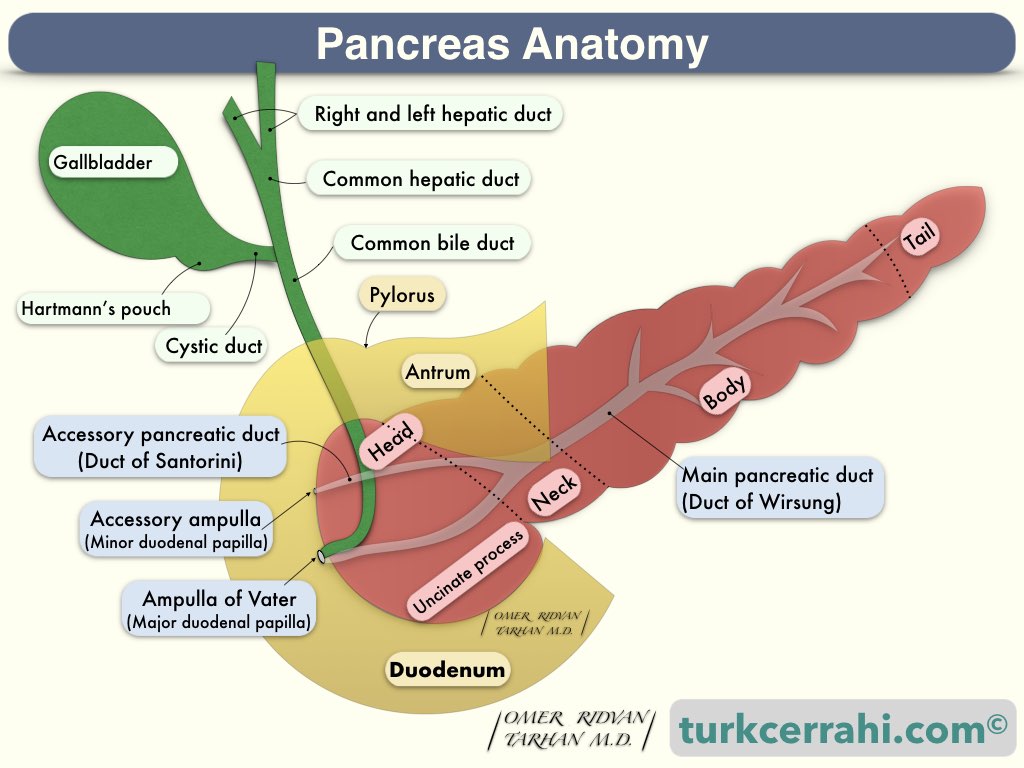Pancreas - Overview

1. Anatomy and Physiology of the Pancreas
The pancreas is a long, flat gland that is 75-110 grams in weight and 15-20 centimeters long. In both ancient Greek and Latin, "pancreas" refers to flat meat. The pancreas is a long retroperitoneal organ that is positioned obliquely behind the stomach. Severe pancreatic pain typically occurs in the epigastrium, but it can also spread to the upper right, left, and/or back quadrants.
The thick pancreatic head is attached to the second part of the duodenum, where the pancreatic duct opens into the duodenum. The thin pancreatic tail is adjacent to the splenic hilum.
The pancreas is a gland that secretes both hormones (endocrine) and digestive enzymes (exocrine). Of the entire pancreas, 85% is the exocrine pancreas, 2% is the endocrine pancreas, and the remaining part is the extracellular matrix (intercellular space) and vessels. Despite accounting for only 2% of pancreatic tissue, islet cells receive 20% of the pancreatic blood supply. 20% intact pancreatic tissue prevents pancreatic insufficiency.
Insulin, the primary hormone secreted by the pancreas, reduces glucose levels in the blood. The production of pancreatic hormones takes place in the islets of Langerhans, which consist of about 300 cells. These hormones provide blood glucose balance.
There are 4 types of cells in the islets of Langerhans
- Alpha (A, 15%) (glucagon)
- Beta (B, 70%) (insulin)
- Delta (D, 10%) (somatostatin)
- Pancreatic Polypeptide (PP or F, 5%) (pancreatic polypeptide).
Insulin-producing B cells are in the center of the islet and make up 70% of it.
Pancreatic juice is produced in the glands of the pancreas. The glands consist of two main structures: the acini (sac) and the duct (duct). Pancreatic fluid (500-800 ml/day) flowing into the duodenum from the pancreatic duct has two functions;
- Carbohydrate, protein, fat digestion (enzymes)
- Neutralization of stomach acid (bicarbonate).
The pancreas secretes 3 main groups of enzymes
- Amylases
- Lipases
- Proteases (trypsinogen, chymotrypsinogen, procarboxypeptidase A and B, ribonuclease, deoxyribonuclease, proelastase)
2. Disease of the Pancreas
Type 1 diabetes is a common pancreatic disease. Other common pancreatic conditions include acute pancreatitis, chronic pancreatitis, pancreatic cancer (exocrine pancreas), and islet cell tumors (endocrine pancreas).
Severe acute pancreatitis can be fatal. Initially, chronic pancreatitis causes abdominal pain attacks. As the disease progresses, persistent abdominal pain, malabsorption, and diabetes occur. As the disease progresses, it can cause abdominal and back pain, weight loss, jaundice, and type 1 diabetes.
Pancreatic cancer spreads rapidly to nearby tissues and the liver, and it is rarely detected early. Islet cell (endocrine pancreas) tumors typically produce hormones and cause a variety of clinical symptoms, such as hypoglycemia, peptic ulcers, and diabetes.